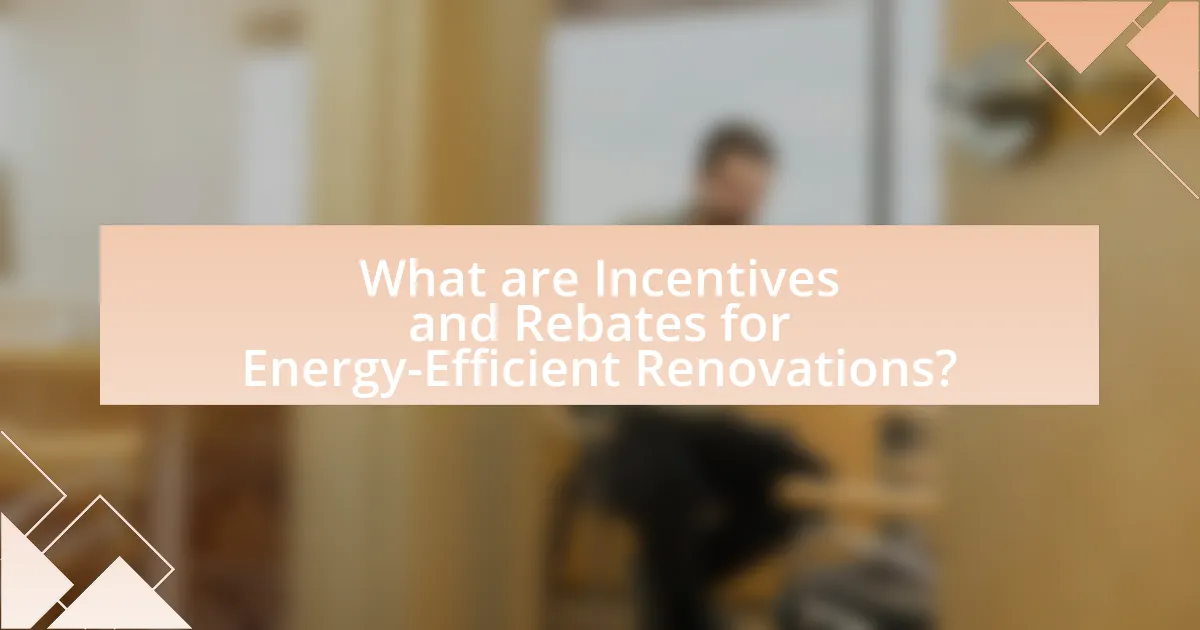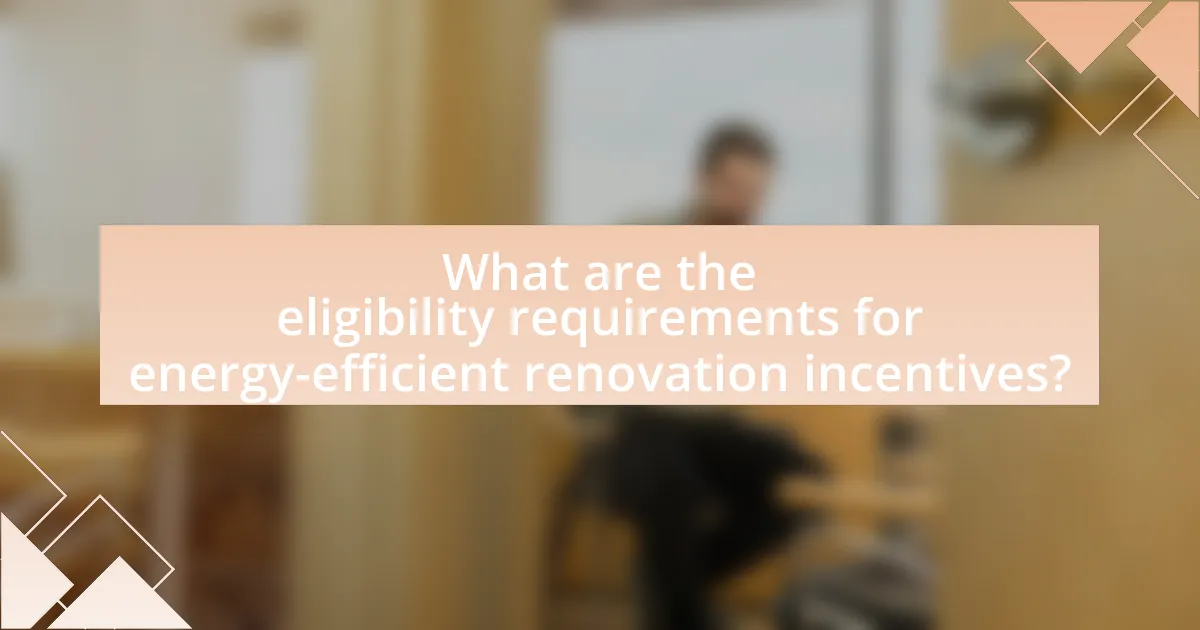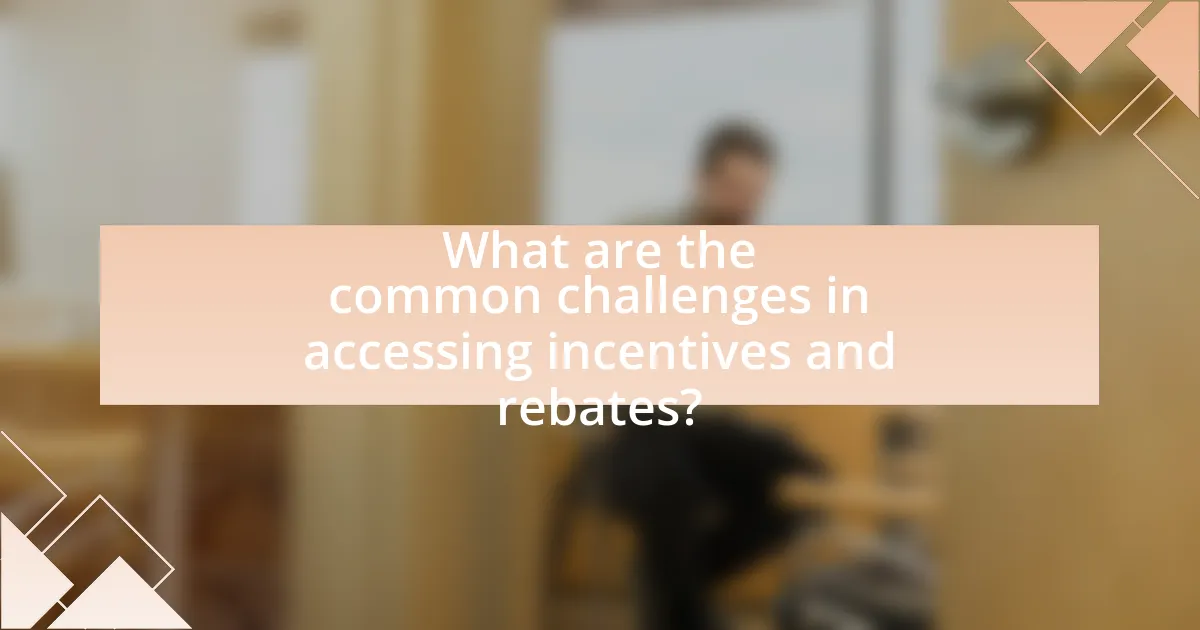Incentives and rebates for energy-efficient renovations are financial benefits provided by governments, utilities, and organizations to promote energy-saving upgrades in homes and businesses. These programs include tax credits, cash rebates, low-interest loans, and grants aimed at reducing the costs of improvements such as insulation, energy-efficient windows, and HVAC systems. The article outlines how these incentives work, the types available, eligibility requirements, and the financial benefits for homeowners. It also addresses common challenges in accessing these programs and offers practical tips for navigating the application process, while highlighting future trends and innovations that may impact the availability of incentives.

What are Incentives and Rebates for Energy-Efficient Renovations?
Incentives and rebates for energy-efficient renovations are financial benefits provided by governments, utilities, or organizations to encourage homeowners and businesses to invest in energy-saving upgrades. These programs can include tax credits, cash rebates, low-interest loans, and grants that reduce the overall cost of renovations such as insulation, energy-efficient windows, and HVAC systems. For example, the U.S. federal government offers tax credits for energy-efficient home improvements under the Energy Policy Act, which can cover a percentage of the costs associated with qualifying renovations. These incentives aim to promote energy conservation, reduce greenhouse gas emissions, and lower energy bills for consumers.
How do these incentives and rebates work?
Incentives and rebates for energy-efficient renovations work by providing financial benefits to homeowners or businesses that invest in energy-saving improvements. These programs are typically funded by government agencies or utility companies to encourage the adoption of energy-efficient technologies, such as solar panels, insulation, or energy-efficient appliances.
For example, a homeowner who installs solar panels may receive a tax credit that reduces their tax liability, or a rebate from their utility company that directly lowers the cost of installation. According to the U.S. Department of Energy, these incentives can significantly offset the upfront costs of energy-efficient upgrades, making them more accessible and appealing to consumers.
What types of incentives are available for energy-efficient renovations?
Various incentives are available for energy-efficient renovations, including federal tax credits, state rebates, and utility company incentives. Federal tax credits, such as the Residential Energy Efficiency Property Credit, allow homeowners to deduct a percentage of the cost of qualifying energy-efficient improvements from their federal taxes. State rebates often provide direct cash back for specific upgrades, such as insulation or energy-efficient windows, and vary by state. Utility companies frequently offer incentives, including rebates or discounts, for energy-efficient appliances and systems to encourage reduced energy consumption. These incentives aim to lower the upfront costs of energy-efficient renovations, making them more accessible to homeowners.
How do rebates differ from tax credits in energy-efficient renovations?
Rebates and tax credits in energy-efficient renovations differ primarily in their application and financial impact. Rebates provide immediate cash back or discounts at the point of purchase, incentivizing consumers to invest in energy-efficient products or services. For example, a homeowner might receive a rebate of $1,000 for installing a high-efficiency HVAC system, reducing the upfront cost directly. In contrast, tax credits reduce the amount of tax owed, allowing homeowners to claim a percentage of their renovation costs on their tax returns. For instance, a tax credit might allow a homeowner to deduct 30% of the cost of solar panel installation from their tax liability, which is realized when filing taxes rather than at the time of purchase. This distinction highlights that rebates offer immediate financial relief, while tax credits provide a delayed benefit through tax savings.
Why are incentives and rebates important for homeowners?
Incentives and rebates are crucial for homeowners because they significantly reduce the financial burden associated with energy-efficient renovations. By providing monetary benefits, these programs encourage homeowners to invest in upgrades that lower energy consumption, ultimately leading to reduced utility bills. For instance, the U.S. Department of Energy reports that energy-efficient improvements can save homeowners up to 30% on their energy costs. Additionally, these incentives can enhance property value, as homes with energy-efficient features often attract higher market prices.
What financial benefits do homeowners gain from these programs?
Homeowners gain significant financial benefits from energy-efficient renovation programs, including tax credits, rebates, and reduced utility bills. These programs often provide direct financial incentives that can cover a portion of renovation costs, such as the Federal Investment Tax Credit, which allows homeowners to deduct a percentage of the cost of solar energy systems from their federal taxes. Additionally, energy-efficient upgrades can lead to lower monthly energy expenses; for example, the U.S. Department of Energy estimates that homeowners can save an average of 20% on their energy bills by implementing energy-efficient measures. Furthermore, increased property value is another financial benefit, as homes with energy-efficient features often sell for more in the real estate market.
How do incentives and rebates encourage energy-efficient practices?
Incentives and rebates encourage energy-efficient practices by providing financial benefits that lower the upfront costs of energy-efficient technologies and improvements. These financial incentives make it more affordable for individuals and businesses to invest in energy-efficient solutions, such as high-efficiency appliances or insulation upgrades. For example, a study by the American Council for an Energy-Efficient Economy found that households receiving rebates for energy-efficient upgrades were 30% more likely to adopt such measures compared to those without financial incentives. This demonstrates that the availability of incentives and rebates directly influences the decision-making process, leading to increased adoption of energy-efficient practices.

What are the eligibility requirements for energy-efficient renovation incentives?
Eligibility requirements for energy-efficient renovation incentives typically include the property being a primary residence, the renovations meeting specific energy efficiency standards, and the homeowner applying for the incentive within a designated timeframe. For instance, many programs require that renovations comply with guidelines set by organizations such as the U.S. Department of Energy or local utility companies, which often specify minimum energy performance ratings. Additionally, homeowners may need to provide documentation of the renovations and proof of energy savings to qualify for the incentives.
Who qualifies for these incentives and rebates?
Individuals and businesses that undertake energy-efficient renovations typically qualify for these incentives and rebates. Eligibility often includes homeowners, landlords, and commercial property owners who implement approved energy-saving measures, such as insulation upgrades, energy-efficient windows, or renewable energy installations. Specific programs may require adherence to guidelines set by local, state, or federal agencies, which often include documentation of the renovation’s energy efficiency and compliance with established standards. For example, the U.S. Department of Energy provides rebates for qualifying energy-efficient appliances and systems, demonstrating that adherence to these criteria is essential for qualification.
What documentation is needed to apply for incentives?
To apply for incentives related to energy-efficient renovations, applicants typically need to provide documentation such as proof of property ownership, detailed project plans, receipts for materials and labor, and energy efficiency certifications. These documents validate the renovation’s compliance with program requirements and demonstrate the financial investment made. For example, many incentive programs require a copy of the energy audit report to confirm that the renovations meet specific efficiency standards, ensuring that the application process is transparent and accountable.
Are there specific energy-efficient standards that must be met?
Yes, there are specific energy-efficient standards that must be met, such as those established by the U.S. Department of Energy (DOE) and the Environmental Protection Agency (EPA). These standards include guidelines like the Energy Star certification, which requires products to meet strict energy efficiency criteria. For example, Energy Star appliances use 10-50% less energy than standard models, contributing to reduced energy consumption and greenhouse gas emissions. Compliance with these standards is often necessary to qualify for various incentives and rebates aimed at promoting energy-efficient renovations.
How can homeowners find available incentives and rebates?
Homeowners can find available incentives and rebates by visiting government websites, utility company portals, and nonprofit organizations focused on energy efficiency. These resources often provide comprehensive lists of financial incentives for energy-efficient renovations, including tax credits, rebates, and grants. For example, the Database of State Incentives for Renewables & Efficiency (DSIRE) offers detailed information on state-specific programs, while the U.S. Department of Energy’s website outlines federal incentives. Additionally, local utility companies frequently have their own rebate programs for energy-efficient appliances and home improvements, which can be accessed through their official websites.
What resources are available for locating local programs?
Local programs for energy-efficient renovations can be located through various resources, including government websites, local utility companies, and community organizations. Government websites often provide comprehensive listings of available incentives and rebates at both state and local levels, such as the U.S. Department of Energy’s Energy Saver site, which details programs by state. Local utility companies frequently offer energy efficiency programs and rebates to encourage residential upgrades, and their websites typically include application details and eligibility criteria. Additionally, community organizations and non-profits focused on sustainability may have information on local initiatives and funding opportunities, further aiding residents in finding relevant programs.
How can online tools assist in identifying applicable incentives?
Online tools assist in identifying applicable incentives by providing centralized databases that aggregate information on various financial incentives, rebates, and tax credits available for energy-efficient renovations. These platforms often utilize user-friendly interfaces that allow individuals to input specific criteria, such as location, type of renovation, and energy efficiency measures, to generate tailored lists of incentives. For instance, the Database of State Incentives for Renewables & Efficiency (DSIRE) offers comprehensive details on state and federal incentives, making it easier for homeowners and contractors to access relevant financial support. This accessibility enhances awareness and encourages participation in energy-efficient programs, ultimately leading to increased adoption of sustainable practices.

What are the common challenges in accessing incentives and rebates?
Common challenges in accessing incentives and rebates include complex eligibility requirements, lack of awareness, and bureaucratic hurdles. Many programs have specific criteria that applicants must meet, which can be difficult to navigate without clear guidance. Additionally, potential recipients often lack information about available incentives, leading to missed opportunities. Bureaucratic processes can further complicate access, as lengthy application procedures and documentation requirements may deter individuals from pursuing these financial benefits. According to a report by the American Council for an Energy-Efficient Economy, these barriers significantly reduce participation rates in energy efficiency programs.
What obstacles do homeowners face when applying for these programs?
Homeowners face several obstacles when applying for energy-efficient renovation programs, including complex application processes, stringent eligibility requirements, and a lack of awareness about available incentives. The complexity of the application process often involves extensive documentation and technical specifications that can be overwhelming for many homeowners. Additionally, eligibility requirements can vary significantly between programs, making it difficult for homeowners to determine if they qualify. A study by the American Council for an Energy-Efficient Economy found that nearly 60% of homeowners are unaware of the incentives available to them, which further complicates their ability to access these programs.
How can homeowners overcome bureaucratic hurdles in the application process?
Homeowners can overcome bureaucratic hurdles in the application process by thoroughly understanding the requirements and guidelines set by local authorities. Familiarizing themselves with the specific documentation needed, deadlines, and eligibility criteria can streamline the process. Additionally, seeking assistance from local government offices or community organizations that specialize in energy-efficient renovations can provide valuable insights and support. Research indicates that homeowners who engage with these resources are more likely to successfully navigate the complexities of the application process, as they receive tailored guidance and clarification on any confusing aspects.
What are the common misconceptions about energy-efficient renovation incentives?
Common misconceptions about energy-efficient renovation incentives include the belief that these incentives are only available for new constructions, that they cover all renovation costs, and that they are too complicated to apply for. In reality, many incentives are specifically designed for existing homes, targeting upgrades like insulation and energy-efficient windows. Additionally, while incentives can significantly offset costs, they typically do not cover the entire expense of renovations. Furthermore, many programs have streamlined application processes, making them accessible to homeowners. According to the U.S. Department of Energy, various federal and state programs exist to support energy-efficient renovations, dispelling the notion that these incentives are limited or overly complex.
What best practices should homeowners follow when pursuing incentives?
Homeowners should conduct thorough research on available incentives and rebates for energy-efficient renovations to maximize their benefits. This involves identifying federal, state, and local programs that offer financial assistance, as well as understanding eligibility requirements and application processes. For instance, the Database of State Incentives for Renewables & Efficiency (DSIRE) provides comprehensive information on incentives across the United States, helping homeowners find relevant programs. Additionally, homeowners should keep detailed records of their renovation projects, including receipts and documentation, to ensure they can substantiate their claims when applying for incentives. Engaging with local energy efficiency organizations can also provide valuable insights and assistance in navigating the incentive landscape.
How can homeowners maximize their benefits from available programs?
Homeowners can maximize their benefits from available programs by thoroughly researching and understanding the specific incentives and rebates offered for energy-efficient renovations. Engaging with local utility companies and government websites can provide detailed information on eligibility criteria, application processes, and deadlines. For instance, the U.S. Department of Energy reports that homeowners who take advantage of federal tax credits for energy-efficient upgrades can receive up to 30% of the cost back, significantly reducing their overall expenses. Additionally, participating in energy audits can help identify the most beneficial upgrades, ensuring that homeowners invest in improvements that yield the highest returns in energy savings and rebates.
What steps should be taken to ensure compliance with program requirements?
To ensure compliance with program requirements for energy-efficient renovations, stakeholders must first familiarize themselves with the specific guidelines and criteria set forth by the program. This involves reviewing documentation provided by the program administrators, which outlines eligibility requirements, application processes, and necessary documentation.
Next, stakeholders should implement a systematic approach to track compliance, including establishing a checklist that aligns with program requirements. This checklist should cover all aspects of the renovation project, from initial planning to final inspections, ensuring that each phase adheres to the stipulated guidelines.
Additionally, regular training sessions for all team members involved in the renovation process can enhance understanding and adherence to compliance standards. Keeping abreast of any updates or changes to the program requirements is also crucial, as regulations may evolve over time.
Finally, conducting periodic audits throughout the renovation process can help identify any areas of non-compliance early, allowing for timely corrective actions. This proactive approach not only ensures compliance but also maximizes the potential for receiving incentives and rebates associated with energy-efficient renovations.
What are the future trends in incentives and rebates for energy-efficient renovations?
Future trends in incentives and rebates for energy-efficient renovations include increased funding from government programs, a shift towards performance-based incentives, and the integration of technology for tracking energy savings. Governments are allocating more resources to support energy efficiency initiatives, as seen in the U.S. with the Inflation Reduction Act, which provides substantial tax credits for energy-efficient home improvements. Performance-based incentives are gaining traction, rewarding homeowners based on actual energy savings rather than upfront costs, promoting long-term efficiency. Additionally, advancements in smart home technology enable better monitoring and reporting of energy usage, facilitating more tailored and effective rebate programs.
How might government policies evolve to support energy efficiency?
Government policies may evolve to support energy efficiency by implementing stricter building codes and offering financial incentives for energy-efficient renovations. Stricter building codes can mandate higher efficiency standards for new constructions and renovations, ensuring that buildings consume less energy. Financial incentives, such as tax credits, rebates, and grants, can encourage homeowners and businesses to invest in energy-efficient technologies. For example, the U.S. Department of Energy has previously supported programs that provide rebates for energy-efficient appliances, demonstrating the effectiveness of financial incentives in promoting energy efficiency.
What innovations in technology could impact the availability of incentives?
Innovations in technology that could impact the availability of incentives include advancements in smart home systems, blockchain for transparent transactions, and artificial intelligence for personalized energy management. Smart home systems enable real-time monitoring and optimization of energy use, which can lead to increased participation in incentive programs. Blockchain technology enhances trust and transparency in incentive distribution, ensuring that funds are allocated efficiently and reducing fraud. Artificial intelligence can analyze user behavior and provide tailored recommendations for energy-efficient upgrades, thereby increasing the uptake of incentives. These technologies collectively enhance the effectiveness and accessibility of incentive programs for energy-efficient renovations.
What practical tips can homeowners use to navigate energy-efficient renovation incentives?
Homeowners can effectively navigate energy-efficient renovation incentives by researching available programs, understanding eligibility requirements, and keeping detailed records of expenses. Researching local, state, and federal incentives can reveal various rebates and tax credits, such as the Federal Energy Efficiency Tax Credit, which offers up to 30% back on qualifying improvements. Understanding eligibility requirements ensures that homeowners select projects that qualify for these incentives, such as installing Energy Star-rated appliances or upgrading insulation. Keeping detailed records of all renovation expenses, including receipts and documentation of energy savings, is crucial for claiming these incentives accurately and maximizing potential savings.